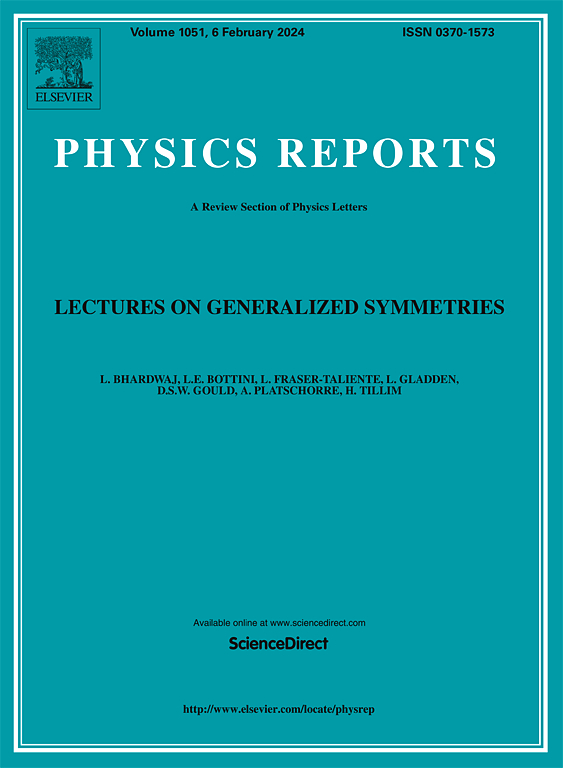阻尼和驱动物理系统中的普遍非线性动力学:从钟摆到约瑟夫森结到电网
IF 29.5
1区 物理与天体物理
Q1 PHYSICS, MULTIDISCIPLINARY
引用次数: 0
摘要
理解动力系统的集体行为对于解释自然和工程环境中的各种紧急现象至关重要。这个过程的一个关键步骤是对单个系统和系统网络进行适当的数学描述。在这种情况下,这里考虑了一系列物理系统,包括经典钟摆、超导约瑟夫森结、电网和其他各种系统。尽管系统在物理结构和应用领域方面存在多样性,但它们表现出惊人的相似的动力学特征,即由惯性和阻尼控制的相动力学,以及它们对外部力的响应。这种观察引起了人们的兴趣,并激发了人们对一个统一的理论框架的探索,这个理论框架能够捕捉到它们在整个系统中表现出的动力学行为的基本原理。本文对二阶相振子动力学的最新研究活动进行了批判性的考察,二阶相振子由于其本身的优点,作为一个简单的非线性动力学模型,代表了广泛的物理系统,因此在这里被称为一个普适类。它提供了一个通用的数学框架来发展一个全面的理解,从一般的角度来看,桥梁,钟摆运动的理论和实验观察,约瑟夫森结,电网和他们的集体行为。虽然这些系统中的每一个都在不同的物理环境中进行了讨论,但它们的底层数学结构显示出很强的共性。特别是,我们强调通过非线性相位动力学的镜头分析这些系统的重要性,以揭示它们的共同机制和系统特定的各种行为。本研究主要集中在一些具体的相互关联的主题上:(i)集体现象和紧急同步;(ii)就系统参数而言,非均质性所扮演的角色,以及噪音对涌现动力的影响;多稳定和复杂的暂态状态;(iv)整合机器学习用于模型发现、控制和预测;(v)相位振荡器模型在不同领域的更广泛的适用性,超出了这里考虑的规范系统。通过在二阶相振子的数学框架内系统地比较不同物理系统的动力学行为,本综述寻求三种系统的非线性动力学的普遍和独特特征,它们的集体行为,如涌现同步、部分同步或嵌合体状态,并具体解释了现实生活中的现象。人群同步可能会导致人行天桥的倒塌和电网的故障。除了我们主要强调这些系统外,还对其他系统进行了简要说明,其中二阶相模型解释了它们的动力学性质。对该主题的广泛综合不仅将加深我们的理论理解,而且还将为自然和工程环境中复杂动力系统的任何设计和控制提供建议。本文章由计算机程序翻译,如有差异,请以英文原文为准。
Universal nonlinear dynamics in damped and driven physical systems: From Pendula via Josephson junctions to power grids
Understanding the collective behavior of dynamical systems is essential for explaining various emergent phenomena in natural and engineered settings. A key step in this process is formulating an appropriate mathematical description of the individual systems and network of systems. In this context, a range of physical systems is considered here, including the classical pendula, superconducting Josephson junctions, power grids, and various others. Despite the diversity of the systems in terms of physical structure and their application domains, they exhibit strikingly similar dynamical features, namely, phase dynamics governed by inertia and damping, and in their response to external forcing. This observation creates interest and motivates a search for a unified theoretical framework capable of capturing the fundamentals of their dynamical behaviors exhibited across the systems. This review critically examines the up-to-date research activities on the dynamics of the second-order phase oscillator, henceforth claimed here as a universality class by its own merits as a simple nonlinear dynamical model representing a broad class of physical systems. It offers a common mathematical framework to develop a comprehensive understanding, from a general perspective, that bridges, the theoretical and experimental observations of pendulum motion, Josephson junctions, and power grids and their collective behaviors. While each of these systems has been discussed in disparate physical contexts, their underlying mathematical structures reveal strong commonalities. In particular, we highlight the importance of analyzing these systems through the lens of nonlinear phase dynamics to uncover their shared mechanisms and system-specific variety of behaviors as well. This survey mainly focuses on some specific interrelated themes: (i) collective phenomena and emergent synchronization; (ii) the role of heterogeneity in terms of system parameters and effects of noise on the emergent dynamics; (iii) multi-stability and complex transient regimes; (iv) the integration of machine learning for model discovery, control, and prediction; and (v) the broader applicability of phase oscillator models across diverse domains beyond the canonical systems considered here. By systematically comparing the dynamical behaviors of the varied physical systems within a cohesive mathematical framework of second-order phase oscillators, this review seeks for the universal and distinctive features of nonlinear dynamics of the three systems, their collective behaviors such as emergent synchrony, partial synchrony, or chimera states, and specifically explains real-life phenomena, and crowd synchrony that may lead to a collapse of a footbridge and the failure of a power grid. Besides our main emphasis on these systems, brief notes have been added on other systems where this second-order phase model explains their dynamical properties. A broad synthesis on the topic will not only deepen our theoretical understanding but also suggest any design and control of complex dynamical systems in both natural and engineered settings.
求助全文
通过发布文献求助,成功后即可免费获取论文全文。
去求助
来源期刊

Physics Reports
物理-物理:综合
CiteScore
56.10
自引率
0.70%
发文量
102
审稿时长
9.1 weeks
期刊介绍:
Physics Reports keeps the active physicist up-to-date on developments in a wide range of topics by publishing timely reviews which are more extensive than just literature surveys but normally less than a full monograph. Each report deals with one specific subject and is generally published in a separate volume. These reviews are specialist in nature but contain enough introductory material to make the main points intelligible to a non-specialist. The reader will not only be able to distinguish important developments and trends in physics but will also find a sufficient number of references to the original literature.
 求助内容:
求助内容: 应助结果提醒方式:
应助结果提醒方式:


